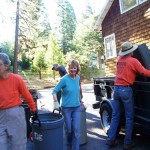At several of this summer’s larger vegetation fires, the Mountain Communities Fire Safe Council was represented. MCFSC Vice President Norm Walker was assigned as incident commander of So Cal Team 1, one of the Fire Management Teams are activated during major fires. Norm has had a 36-year career with the U.S. Forest Service as a fire officer, and continues to be part of their FMTs.
I asked him to offer some insight and comments on the fires with which he was involved this year. His observations of these fires’ behaviors and experiences during his presence there may give us some insight to what the potential for a fire in our forest could be.
The fires we experienced this summer were a reminder of how volatile vegetation can be in the western United States. Coupled with the ongoing drought, which leads to insect-caused tree mortality, the stage was set for a massive fire season. The only thing missing was an ignition source.
In late June, the Lake Fire broke out near Big Bear at about 7,000-foot elevation. Normally, a fire at that elevation and that early in fire season would be caught with the initial attack resources at 10 acres or less. However, the extremely low fuel moistures from the drought caused the fire to keep spotting out ahead of the firefighter’s hose lays and to expand rapidly through the understory and the timber.
A ridge coming off of San Gorgonio peak is called 10,000 Foot Ridge. At that elevation, the trees are small and sparse and, for the most part, there is little ground fuel. In the past, if a fire even made it up that high, it would go out by itself due to lack of ground fuel and the presence of snow (in June) on the north slopes. But not this year. The fire burned right through all of that, over the ridge and down toward the desert.
The good news on the Lake Fire was that it was the only major fire burning at the time and we were able to throw all the resources we wanted at it from the U.S. Forest Service, Cal Fire and local governments, so it was held to a reasonable size (about 24,000 acres.) with minimal structure loss compared to what was about to happen to California in August.
In August and early September, at least three major lightning storms moved through Central and Northern California. Burning conditions varied depending on wind and slope alignment, so some of the fires did benefit the environment. But many of them were very damaging and destroyed thousands of homes and hundreds of thousands of acres of standing timber.
A major difference between the Lake Fire and these fires was the lack of firefighting resources. Most agencies were tapped out by the third lightning storm, and many of the fires that had Incident Management Teams assigned to them had very few firefighting resources assigned. Most IMTs had between four and eight fires assigned to them and not only had to prioritize which fires to fight but what area of individual fires to fight due to lack of resources.
Homes and infrastructure were the priority and open forest was not. Some fires burning in wilderness areas were simply monitored with future plans made for when fire crews became available.
So this brings us to the point of fire abatement in communities. If there are a few fires burning in California, the chance of your home being protected by fire engines is pretty good. But when there is a siege going on, your home must stand on whatever abatement has been done prior to the fire.
It is one thing to pass your P.R.C. 4291 inspection in the spring; but it is another to keep up on that abatement throughout the year.
Once evacuation orders are in place, your home’s ability to resist ignition is dependent upon what you did up until that time to keep grasses from growing back up to the structure and how well you managed the continuing pine-needle drop everywhere on your land.
Fire has no brain and no emotions. It is an exothermic reaction caused by the combination of fuel, heat and oxygen. We have ignitions every year and there is always oxygen, so the only thing under our control is fuel. We can remove fuel once a year to pass our fire inspection or we can be vigilant all year long, which may raise the odds in our favor.
As Santa Ana wind season approaches, please be vigilant. It’s the price we pay for the lifestyle we chose to live.










